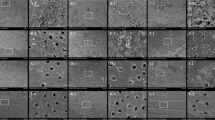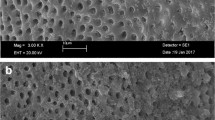Abstract
Some lasers have demonstrated to provide effective disinfection when used as adjunctive device to the conventional treatment. The aim of this in vitro study was to determine the effectiveness of the erbium, chromium:yttrium scandium gallium garnet (Er, Cr:YSGG) laser by measuring its bactericidal effect inside the root canal experimentally colonized with Enterococcus faecalis. The laser was tested at different irradiation times (30 and 60 s) and energy of impulses (75 and 25 mJ). A total of 52 single-rooted extracted human teeth were endodontically prepared with rotary instrumentation. All were sterilized and inoculated with a suspension of E. faecalis (105 bacteria/ml). The teeth were randomized into three treatment (group 1, group 2, and group 3) and one control groups. In all groups, teeth were chemically irrigated with 5.25 % sodium hypochlorite and 17 % ethylenediaminetetraacetic acid. Groups 1 and 2 were also irradiated at 30 and 60 s, respectively, with an Er, Cr:YSGG laser at 75 mJ. Teeth of group 3 were treated with laser for 60 s at 25 mJ. Samples were processed to detect the presence of E. faecalis. For all groups, a bactericidal effect was observed. The use of laser at 75 mJ with an irradiation time of 30 and 60 s eliminated a percentage of 92.3 and 100 % of E. faecalis, respectively. In the control group, a reduction of 92.3 % was observed. Lower percentage of reduction (46.1 %) was obtained in teeth treated with laser at 25 mJ for 60 s. No statistical differences were observed between the groups (P = 0.543, Fisher’s exact test). The results indicated a bactericidal effect of Er, Cr:YSGG laser irradiation at the settings used in this study. The highest bactericidal effect of this laser was observed at 60 s of irradiation time, using an energy pulse of 75 mJ.



Similar content being viewed by others
References
Gomes BP, Pinheiro ET, Gadê-Neto CR et al (2004) Microbiological examination of infected dental root canals. Oral Microbiol Immunol 19:71–76
Hancock HH, Sigurdsson A, Trope M, Moiseiwitsch J (2001) Bacteria isolated after unsuccessful endodontic treatment in a North American population. Oral Surg Oral Med Oral Pathol Oral Radiol Endod 91:579–586
Pinheiro EP, Gomes BP, Ferraz C et al (2003) Microorganisms from canals of root-filled teeth with periapical lesions. Int Endod J 36:1–11
Sood S, Malhotra M, Das BK, Kapil A (2008) Enterococcal infections & antimicrobial resistance. Indian J Med Res 128:111–121
Skucaite N, Peciuliene V, Vitkauskiene A, Machiulskiene V (2010) Susceptibility of endodontic pathogens to antibiotics in patients with symptomatic apical periodontitis. J Endod 36:1611–1616
Peters OA, Peters CI, Schonenberger K, Barbakow F (2003) ProTaper rotary root canal preparation: effects of canal anatomy on final shape and analysed by micro CT. Int Endod J 36:86–92
de los Angeles Bulacio M, Raiden G (2009) Dye diffusion in instrumented root canals irrigated with different solutions. Acta Odontol Latinoam 22:207–214
Alves FR, Almeida BM, Neves MA et al (2011) Disinfecting oval-shaped root canals: effectiveness of different supplementary approaches. J Endod 37:496–501
Zou L, Shen Y, Li W, Haapasalo M (2010) Penetration of sodium hypochlorite into dentin. J Endod 36:793–6
Kuga MC, Gouveia-Jorge É, Tanomaru-Filho M et al (2011) Penetration into dentin of sodium hypochlorite associated with acid solutions. Oral Surg Oral Med Oral Pathol Oral Radiol Endod 112:155–159
Pérez-Heredia M, Ferrer-Luque CM, González-Rodríguez MP (2006) The effectiveness of different acid irrigating solutions in root canal cleaning after hand and rotary instrumentation. J Endod 32:993–997
Nair PNR, Henry S, Cano V et al (2005) Microbial status of apical root canal system of human mandibular first molars with primary apical periodontitis after ‘one-visit’ endodontic treatment. Oral Surg Oral Med Oral Pathol Oral Radiol Endod 99:231–252
Kimura Y, Wilder Smith P, Matsumoto K (2000) Laser in endodontics: a review. Int Endod J 33:173–85
Sadık B, Arıkan S, Beldüz N et al (2013) Effects of laser treatment on endodontic pathogen Enterococcus faecalis: a systematic review. Photomed Laser Surg 31:192–200
Sulewski JG (2009) Making the most of the 16th Annual Conference and Exhibition: a practical orientation for attendees. In: Academy of Laser Dentistry 16th annual conference and exhibition, Las Vegas, Nevada
Plotino G, Grande NM, Falanga A et al (2007) Dental removal in the coronal portion of root canals following two preparation techniques. Int Endod J 40:853–858
Neglia R, Ardizzoni A, Giardino L et al (2008) Comparative in vitro and ex vivo studies on the bactericidal activity of Tetraclean, a new generation endodontic irrigant, and sodium hypochlorite. New Microbiol 31:57–65
Siqueira JF, Machado AG, Silveira RM, Lopes HP, De Uzeda M (1997) Evaluation of the effectiveness of sodium hypochlorite used with three irrigation methods in the elimination of Enterococcus faecalis from the root canal in vitro. Int Endod J 30:279–282
Oncag O, Hosgor M, Hilmioglu S et al (2003) Comparison of antibacterial and toxic effects of various root canal irrigants. Int Endod J 36:423–432
Levy G, Rizoiu I, Friedman S, Lam H (1996) Pressure waves in root canals induced by Nd: YAG laser. J Endod 22:81–4
Gutarts R, Nusstein J, Reader A, Beck M (2005) In vivo debridement efficacy of ultrasonic irrigation following hand-rotary instrumentation in human mandibular molars. J Endod 31:166–170
Tomita Y, Shima A (1986) Mechanisms of impulsive pressure generation and damage pit formation by bubble collapse. J Fluid Mech 169:535–564
DiVito E, Peters OA, Olivi G (2012) Effectiveness of the erbium:YAG laser and new design radial and stripped tips in removing the smear layer after root canal instrumentation. Lasers Med Sci 27:273–280, 18
Gordon W, Atabakhsh VA, Meza F et al (2007) The antimicrobial efficacy of the erbium, chromium:yttrium-scandium-gallium-garnet laser with radial emitting tips on root canal dentin walls infected with Enterococcus faecalis. J Am Dent Assoc 138:992–1002
Del Carpio-Perochena AE, Bramante CM, Duarte MA et al (2011) Biofilm dissolution and cleaning ability of different irrigant solutions on intraorally infected dentin. J Endod 37:1134–1138
Arnabat J, Escriban C, Fenosa A et al (2012) Bactericidal activity of erbium, cromium: yttrium-scandium-gallium-garnet laser in root canals. Lasers Med Sci 25:805–810
Cheng X, Guan S, Lu H et al (2012) Evaluation of the bactericidal effect of Nd:YAG, Er:YAG, Er, Cr:YSGG laser radiation, and antimicrobial photodynamic therapy (aPDT) in experimentally infected root canals. Lasers Surg Med 44:824–831
Peeters HH, Suardita K (2011) Efficacy of smear layer removal at the root tip by using ethylenediaminetetraacetic acid and erbium, chromium: yttrium, scandium, gallium garnet laser. J Endod 37:1585–1589
Eldeniz AU, Ozer F, Hadimli HH, Erganis O (2007) Bactericidal efficacy of Er, Cr; YSGG laser irradiation against Enterococcus faecalis compared with NaOCl irrigation: an ex vivo pilot study. Int End J 40:112–119
Peeters HH, Mooduto L (2012) Radiographic examination of apical extrusion of root canal irrigants during cavitation induced by Er, Cr:YSGG laser irradiation: an in vivo study. Clin Oral Investig. doi:10.1007/s00784-012-0910-2
Hülsmann M, Hahn W (2000) Complications during root canal irrigation literature: review and case reports. Int Endod J 33:186–193
Zairi A, Lambrianidis T (2008) Accidental extrusion of sodium hypochlorite into the maxillary sinus. Quintessence Int 39:745–748
Pawar R, Alqaied A, Safavi K, Boyko J, Kaufman B (2012) Influence of an apical negative pressure irrigation system on bacterial elimination during endodontic therapy: a prospective randomized clinical study. J Endod 38:1177–1181
de Gregorio C, Paranjpe A, Garcia A et al (2012) Efficacy of irrigation systems on penetration of sodium hypochlorite to working length and to simulated uninstrumented areas in oval shaped root canals. Int Endod J 45:475–481
Author information
Authors and Affiliations
Corresponding author
Rights and permissions
About this article
Cite this article
Licata, M.E., Albanese, A., Campisi, G. et al. Effectiveness of a new method of disinfecting the root canal, using Er, Cr:YSGG laser to kill Enterococcus faecalis in an infected tooth model. Lasers Med Sci 30, 707–712 (2015). https://doi.org/10.1007/s10103-013-1410-6
Received:
Accepted:
Published:
Issue Date:
DOI: https://doi.org/10.1007/s10103-013-1410-6




